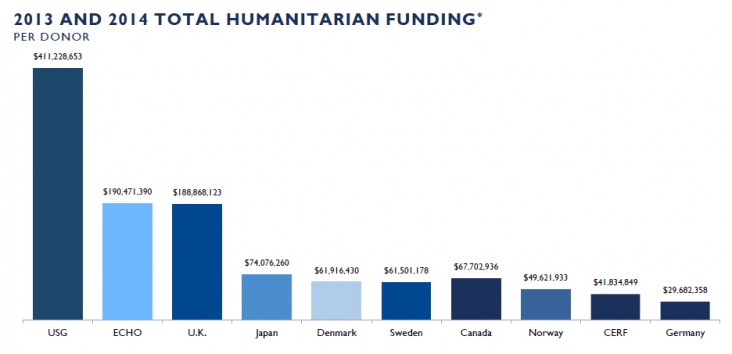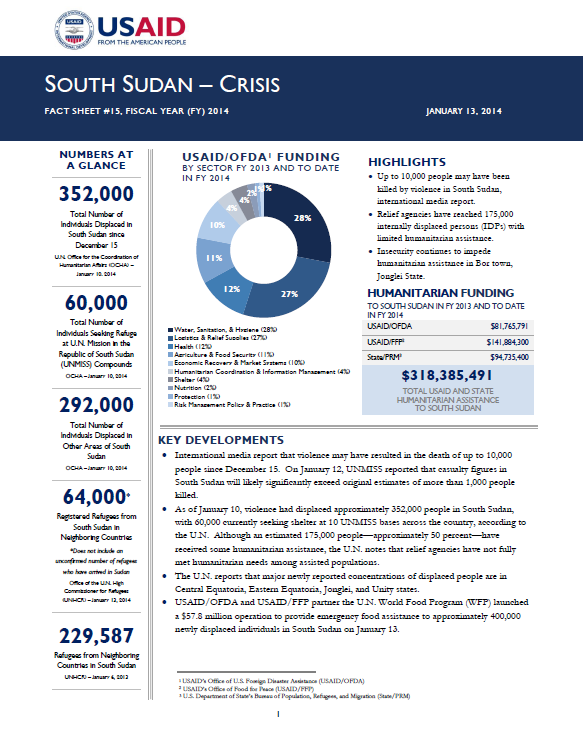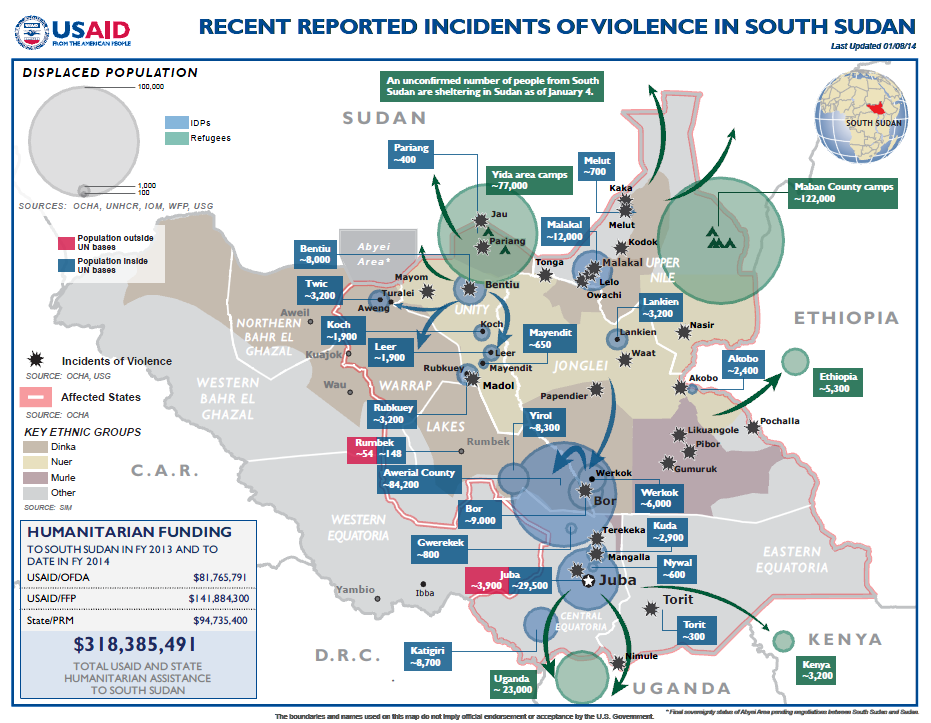- What We Do
- Agriculture and Food Security
- Democracy, Human Rights and Governance
- Economic Growth and Trade
- Education
- Environment and Global Climate Change
- Gender Equality and Women's Empowerment
- Global Health
- Humanitarian Assistance
- Transformation at USAID
- Water and Sanitation
- Working in Crises and Conflict
- U.S. Global Development Lab
Speeches Shim
February 28, 2014
Numbers At A Glance
695,200
75,600
619,600
190,000
233,300
Humanitarian Funding:
To South Sudan To Date In FY2013 and FY2014:
| USAID/OFDA | $87,174,812 |
| USAID/FFP | $141,884,300 |
| State/PRMDoD | $94,735,400 |
| TOTAL | $323,794,512 |
Highlights
Relief agencies remain on high alert in response to rumors of potential attacks in Bentiu town, Unity State.
Humanitarian response to displaced populations sheltering outside of UNMISS compounds increases in South Sudan.
Limited humanitarian assistance reaches more than 361,000 people.
KEY DEVELOPMENTS
Vulnerable populations continue to flee ongoing fighting in South Sudan, with violence displacing nearly 885,000 people—including both internally displaced persons (IDPs) and refugees fleeing to neighboring countries—since December 15, according to the U.N.
UNMISS reports that Malakal town, Upper Nile State, is deserted and the security situation remains tense following heavy fighting between Government of the Republic of South Sudan (RSS) forces and armed opposition groups that erupted on February 18. The U.N. reports that nearly 22,000 civilians are currently sheltering at the Malakal UNMISS base and, although many international humanitarian agencies evacuated relief staff, critical staff members remain to continue emergency assistance operations and provide basic services for IDPs.
Fear of potential attacks in Unity’s capital of Bentiu have prompted more than 1,000 people to seek shelter at the local UNMISS base; relief actors continue to monitor the situation.
Humanitarian organizations are reaching an increased number of the more than 619,000 people currently sheltering outside of the UNMISS bases throughout South Sudan as a result of the gradually improving security situation in key areas, including Juba town, Central Equatoria State, and Mingkaman town, Awerial County, Lakes State, according to the U.N.
Although insecurity continues to constrain humanitarian access to conflict-affected areas, relief agencies have provided food assistance to approximately 291,000 people and nutrition assistance to nearly 106,000 people since December 15, according to the U.N.
SITUATION, DISPLACEMENT, AND HUMANITARIAN NEEDS UPDATE
Population movements remain fluid in many areas of South Sudan as the security situation continues to fluctuate erratically in conflict-affected areas. The International Organization on Migration (IOM) reports that nearly 5,000 IDPs arrived in Renk town, Upper Nile, from Baliet, Malakal, and Manyo counties, Upper Nile, as of February 14. Despite relative security in Renk town, unconfirmed numbers of IDPs and host community members reportedly began moving north toward the Sudanese border, due to increasing tensions in many parts of Upper Nile.
Active hostilities continue to affect populations in Jonglei, Unity, and Upper Nile states with clashes between RSS and opposition forces in Bor town, and Duk and Twic East counties, Jonglei, causing approximately 5,200 IDPs to relocate to the IDP camp in Mingkaman, according to the U.N. World Health Organization (WHO). In addition, fear of potential attacks in Unity’s capital of Bentiu have prompted more than 1,000 people to seek shelter at the local UNMISS base—currently hosting more than 4,500 IDPs—and tensions remain high. In an effort to prevent looting and occupation of U.N. and non-governmental organization (NGO) compounds in the event of an attack, relief agencies are engaging with local Sudan People’s Liberation Army (SPLA) leadership and continue to closely monitor the situation.
Following the initial attacks that took place in Malakal town and in the local UNMISS base on February 18, medical facilities also became targets of violence by armed groups. International NGO (INGO) Médecins Sans Frontières (MSF) reports that armed actors killed at least 14 people in a local hospital, burned and looted a number of medical clinics, and completely destroyed another hospital. In addition, the hospital in Leer County, Unity, also suffered severe looting and destruction, effectively denying thousands of people critical, life-saving medical care, according to MSF.
South Sudan Crisis Fact Sheet #31 February 28, 2014 ![]() (pdf - 290k)
(pdf - 290k)
South Sudan Crisis Map February 28, 2014 ![]() (pdf - 973k)
(pdf - 973k)
HUMANITARIAN RESPONSE ACTIVITIES
Although humanitarian organizations have reached approximately 361,700 people with humanitarian assistance since hostilities erupted on December 15, relief agencies have not fully met needs among assisted populations due to insecurity and a lack of sustained, predictable access, according to the U.N. Among those assisted, approximately 166,500 people have received medicines and medical consultations, while measles and polio vaccination efforts have reached nearly 220,000 children. Nearly 291,000 people have received emergency food assistance.
Despite ongoing insecurity and access constraints, USAID/FFP partner the U.N. World Food Program (WFP) continues to provide urgently needed food and nutrition assistance to vulnerable people in conflict-affected areas—including the estimated 75,600 civilians currently seeking protection in eight UNMISS bases across South Sudan. WFP reports that emergency food security assessments are underway in Jonglei, Unity, and Upper Nile.
USAID/OFDA partner WHO is working to provide cholera vaccinations for approximately 140,000 people in Juba and Awerial County. As of February 24, WHO vaccinated approximately 38,300 people in Awerial during the first phase of its oral cholera vaccination campaign with plans to reach nearly 55,700 additional IDPs in the coming days. INGO Medair—with support of WHO, RSS Ministry of Health, and the U.N. Children’s Fund (UNICEF)—also began a cholera vaccination campaign on February 27, in Juba, according to WHO.
Jonglei
In response to ongoing emergency food and nutrition needs among displaced populations, WFP distributed 30-day half rations of emergency food commodities—including sorghum, pulses, vegetable oil, and salt—to nearly 4,900 people sheltering at the UNMISS compound in Bor.
The U.N. Mine Action Service (UNMAS) deployed a contractor to Bor to carry out assessments of U.N. premises and conduct surveys in local villages to identify unexploded ordnance.
In response to gaps in mental health and psychosocial support identified by the Health and Protection clusters—the coordinating bodies for humanitarian health and protection activities, comprising U.N. agencies, NGOs, and other stakeholders—IOM trained eight community members to conduct psychosocial assessments in the IDP community in Bor.
Lakes
In response to ongoing health and nutrition needs, WFP is providing targeted nutrition support to include supplementary feeding programs for children and pregnant and lactating women in Awerial.
Humanitarian actors reached nearly 2,480 families with shelter assistance and approximately 1,400 families with emergency relief supplies in Mingkaman.
Unity
IOM is providing ongoing reproductive health services and conducting health education campaigns in Bentiu. A mobile clinic also began operating in Bentiu during the week of February 17, conducting an average of 30-40 consultations per day, according to IOM.
Upper Nile
Despite ongoing fighting, relief agencies are providing essential nutrition, health, water, sanitation and hygiene (WASH), and emergency food assistance support in Malakal and the local UNMISS base. INGO World Vision provided nearly 68 metric tons of food to approximately 9,000 people affected by the recent violence that erupted in Malakal on February 18. As security permits, World Vision plans to extend its emergency food and relief supply distribution to Rom town, located 80 kilometers north of Malakal, where new fighting has displaced an estimated 10,000 people. In addition, WFP continues to support supplementary feeding programs for children and pregnant and lactating women in the Malakal UNMISS base.
With nearly $2.6 million in ongoing FY 2013 USAID/OFDA funding, INGO Medair is providing emergency health, nutrition, and WASH services to IDPs, Sudanese returnees, and host community populations in Renk. Medair reports treating more than 1,000 patients per week at emergency medical facilities in Mina and Abayouk returnee sites—the majority of whom are suffering from respiratory tract infections, malaria, and acute watery diarrhea. Although medical clinics in Renk are running low on pharmaceutical supplies sufficient supplies are located in Malakal and are available for transport to Renk facilities once security conditions permit, according to the U.N.
IOM is delivering 20,000 liters of water per day to approximately 1,000 IDPs currently sheltering at the Melut town UNMISS base.
OTHER HUMANITARIAN ASSISTANCE
To date, international donors have provided approximately $264 million—or nearly 20.8 percent of the $1.27 billion total requested funding—to support humanitarian activities through the South Sudan Crisis Response Plan. Although relief agencies have received an additional $9.4 million in pledges, the U.N. reports that additional funding is needed to efficiently implement life-saving services and secure relief commodities for all core pipelines.

*Funding figures are as of February 28, 2014. All international figures are according to OCHA’s Financial Tracking Service (FTS) and based on international commitments during the 2013 and 2014 calendar years. USG figures are according to the USG and reflect the most recent USG commitments based on the 2013 fiscal year, which began on October 1, 2012, and ended September 30, 2013, as well as the 2014 fiscal year, which began on October 1, 2013.



Comment
Make a general inquiry or suggest an improvement.